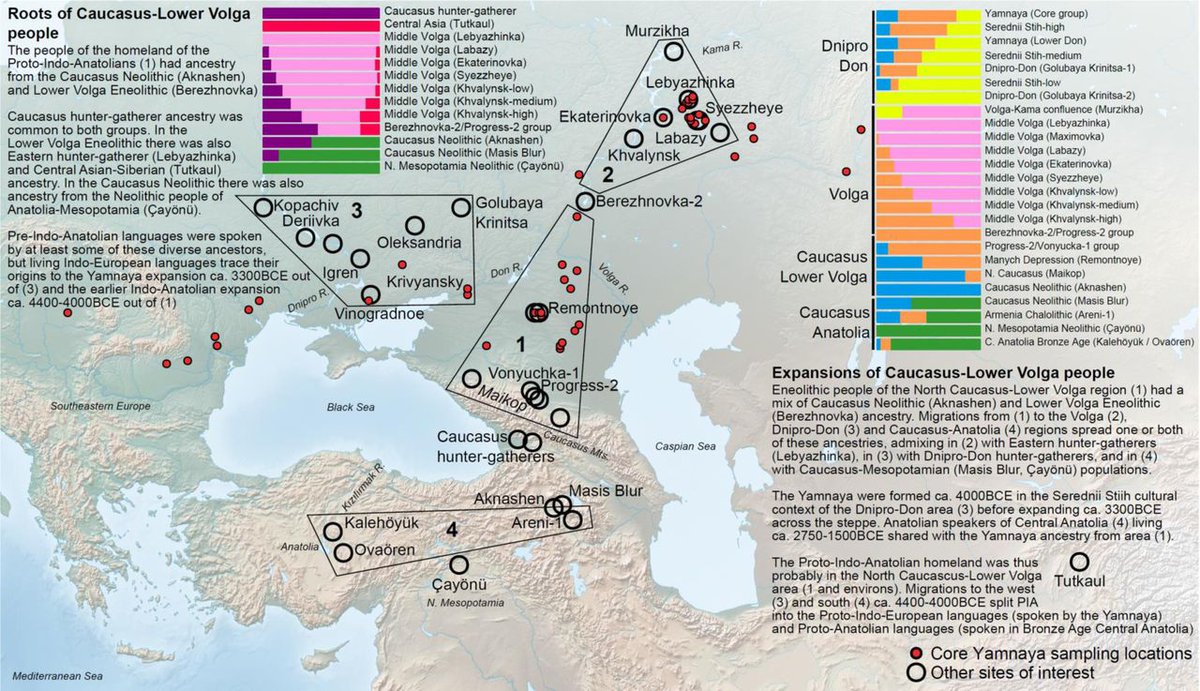Our papers, out today in @nature, show how ancient DNA from the Eneolithic and Bronze Age steppe points to a North Pontic origin of the Indo-European language family and a Caucasus-Lower Volga (CLV) origin of Indo-Anatolian (inclusive of the now extinct Anatolian languages). 1/ 

"The genetic origin of the Indo-Europeans" describes our solution: a Caucasus-Lower Volga homeland of Proto-Indo-Anatolian speakers and a North Pontic (or Dnipro-Don) homeland of the Proto-Indo-Europeans which we identify as the Yamnaya. 2/
nature.com/articles/s4158…
nature.com/articles/s4158…
"A genomic history of the North Pontic Region from the Neolithic to the Bronze Age" focuses on how CLV migrants crossed or settled the steppes north of the Black Sea, and mixed in distinct waves with its local farmers and hunter-gatherers. 3/
nature.com/articles/s4158…
nature.com/articles/s4158…
The Yamnaya, proximal scions of the Serednii Stih archaeological culture that preceded them in the Eneolithic North Pontic region, and more distally composed of a mix of CLV newcomers and Dnipro-Don hunter-gatherers, largely eclipsed the previous inhabitants of the steppe. 4/
The Yamnaya's precursors were formed by admixture ca. 4000BCE and experienced an interlude of relative isolation before the emergence of the Yamnaya horizon ca. 3300BCE. Our best guess of where this happened is in the vicinity of Mykhailivka in the Lower Dnipro in Ukraine. 5/ 

CLV people crossed the Caucasus (in sites labeled in bold) via Armenia, north Mesopotamia, and eastern Anatolia before reaching Central Anatolia and becoming the ancestors of people with mostly Mesopotamian but ~10% CLV ancestry that may have spoken Anatolian languages. 6/ 

We wrote a small retrospective and description of our results in the context of a nearly 15-year-long search for the answer to the Indo-European puzzle that gives some of the background of how we ended up on this solution. 7/
communities.springernature.com/posts/indo-eur…
communities.springernature.com/posts/indo-eur…
This was obviously the work of many people, most importantly my friend and mentor Nick Patterson, the knower of all things Indo-European David Anthony, the indefatigable Leonid Vyazov, my long-time collaborator Ron Pinhasi, the ever curious and insightful Alex Nikitin... 8/
... and most of all David Reich who has done more for the science of ancient DNA (*) and for co-ordinating these very complex and demanding studies and engaging with all their scientific and practical aspects over many years.
(*) except a certain Swedish Nobel winner :)
9/
(*) except a certain Swedish Nobel winner :)
9/
I wished, when our preprints came out, that the war raging over the Indo-European homelands, would soon end. May the spirit of open-mindedness and collaboration between our many, especially Ukrainian and Russian co-authors, prevail over the senseless hatreds of the day. end/
• • •
Missing some Tweet in this thread? You can try to
force a refresh












